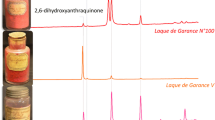Abstract
Microsamples of pink cosmetic powders from the Greco–Roman period were analyzed using two complementary analytical approaches for identification of the colouring agents (lake pigments originally manufactured from madder plants with an inert binder, usually a metallic salt) present in the samples. The first technique was a methanolic acidic extraction of the archaeological samples with an additional ethyl acetate extraction of the anthraquinone-type colouring agents which were identified using high performance liquid chromatography coupled to electrospray ionization with high resolution mass spectrometry (LC–ESI–HRMS), and the second was direct analysis of a microsample by laser desorption ionization–mass spectrometry (LDI–MS). The latter technique is well suited when the quantity of samples is very low. This soft ionization technique enables the detection of very small quantities of compounds using the combination of positive and negative-ion modes. It was also successfully applied for the direct analysis of some laboratory-made reference compounds. However, the presence of lead in one of these ancient samples induced a spectral suppression phenomenon. In this case and conditional on a sufficient quantity of available sample, the former method is better adapted for the characterization of these anthraquinone-type molecules. This study also confirmed that purpurin, munjistin, and pseudopurpurin are the principal colouring agents present in these ancient cosmetic powders constituted from madder plants.





Similar content being viewed by others
References
Grillet B (1975) Les femmes et les fards dans l’antiquité grecque. CNRS, Lyon
Dubourdieu A, Lemirre E (2002) Corps Romains. Jerôme Millon, Grenoble
Guineau B, Fauduet I, Biraben JM (1995) Germania 2:369–401
Mazzocchin GA, Agnoli F (2003) Anal Chim Acta 475:181–190
Wim H, Van Lith S (2006) BABesch 81:185–198
Fitzhugh EW (1997) Artists’ pigments: a handbook of their history and characteristics 3. National Gallery of Art, Washington
Welcomme E, Walter P, Van Elslande E, Tsoucaris G (2006) Appl Phys A 83:551–556
Martinetto P, Anne M, Dooryhée E, Drakopoulos M, Dubus M, Salomon J, Simionovici A, Walter P (2001) Nucl Instr Methods B 181:744–748
Wouters J (1985) Stud Conserv 30:119–128
Ferreira ESB, Quye A, McNab H, Hulme AN (2000) Dyes Anc Textiles Dyes Hist Archaeol 18:63–72
Sanyova J, Reisse J (2006) J Cult Heritage 7:229–235
Wouters J, Vanden Berghe I, Richard G, Breniaux R Cardon D (2002) Proc 21st Int Congr Dyes in History and Archaeology (to be published)
Rafaëlly L, Héron S, Nowik W, Tchapla A (2008) Dyes Pigments 77:191–203
Puchalska M, Orliska M, Ackacha MA, Polek-Pawlak K, Jarosz M (2003) J Mass Spectrom 38:1252–1258
Derksen GCH, Niederländer HAG, van Beek TA (2002) J Chromatogr A 978:119–127
Grim DM, Alisson J (2003) Int J Mass Spectrom 222:85–99
Maier MS, Parera SD, Seldes AM (2003) Int J Mass Spectrom 232:225–229
Siegel J, Allison J, Mohr D, Dunn J (2005) Talanta 67:425–429
Schweppe H (1992) Handbuch der Naturfarbstoffe Vorkommen, Verwendung, Nachweis Ecomed Verlagsgesellschaft Landsberg
Kiel EG, Heertjes PM (1963) J Soc Dyers Colourists 79:61–64
Soubayrol P, Dana G, Man PP (1996) Magn Reson Chem 34:638–645
Wyplosz N (2003) Laser desorption mass spectrometric studies of artists’ organic pigments. PhD dissertation, Amsterdam
Schweppe H (1989) Historic textile and paper materials II. Conservation and characterization. American Chemical Society, Washington
Clementi C, Nowik W, Romani A, Cibin F, Favaro G (2007) Anal Chim Acta 596:46–54
Sanyova J (1998) Art et chimie la couleur. CNRS, Paris
Acknowledgements
The authors are grateful to Dr K. Goethert-Polaschek (Rheinisches Landesmuseum Trier, Germany), Dr F. Naumann-Steckner (Römisch-Germanisches Museum of Cologne, Germany), and Dr V. Adrimi-Sismani (Museum of Volos, Greece) for providing samples from Wederath (Germany), Cologne (Germany) and Demetrias (Greece), respectively. The authors want also to thank Mr D. Good from L’Oréal and Dr A. Brunelle from ICSN for reviewing this manuscript.
Author information
Authors and Affiliations
Corresponding author
Rights and permissions
About this article
Cite this article
Van Elslande, E., Guérineau, V., Thirioux, V. et al. Analysis of ancient Greco–Roman cosmetic materials using laser desorption ionization and electrospray ionization mass spectrometry. Anal Bioanal Chem 390, 1873–1879 (2008). https://doi.org/10.1007/s00216-008-1924-0
Received:
Revised:
Accepted:
Published:
Issue Date:
DOI: https://doi.org/10.1007/s00216-008-1924-0




